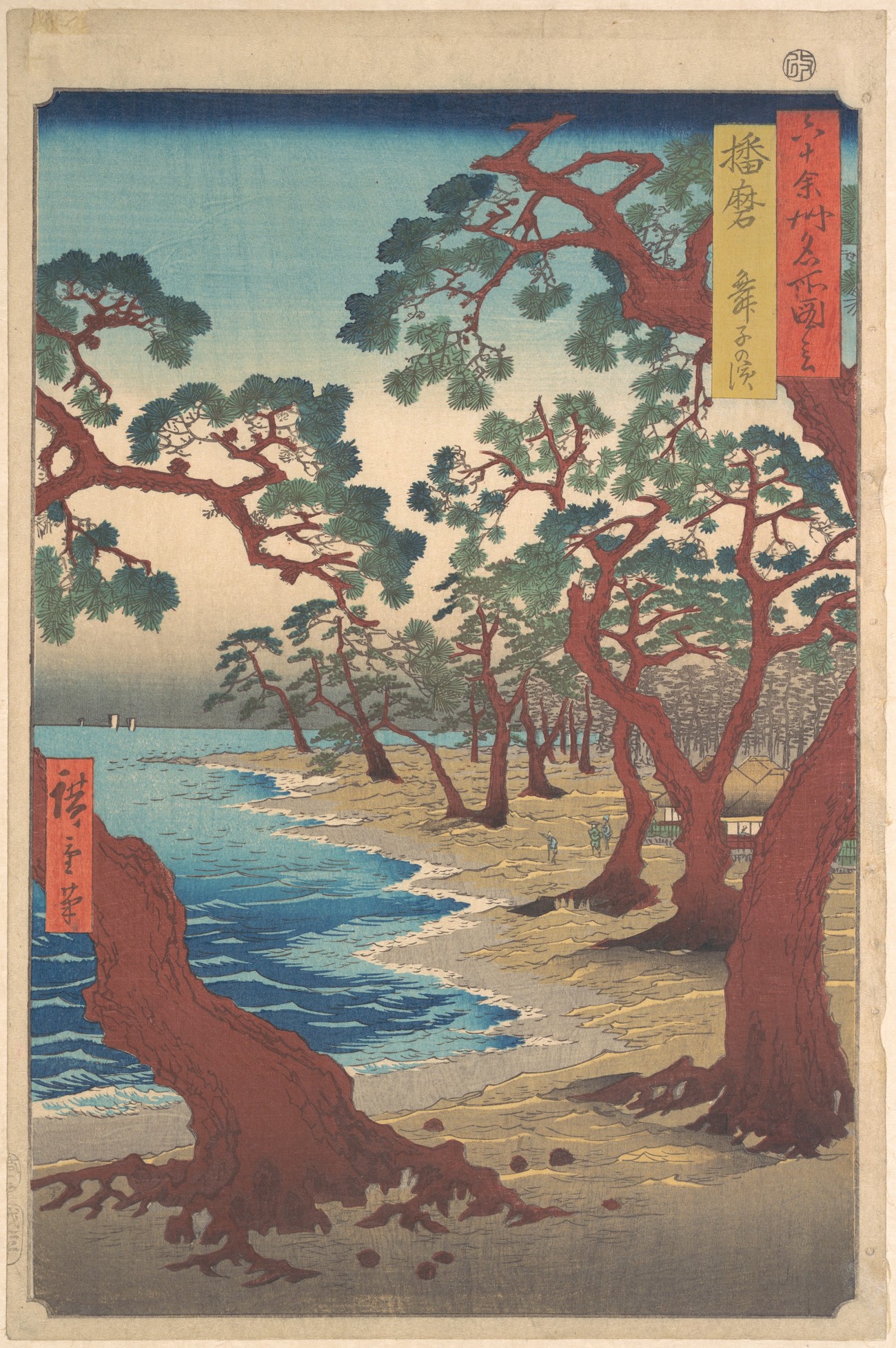-
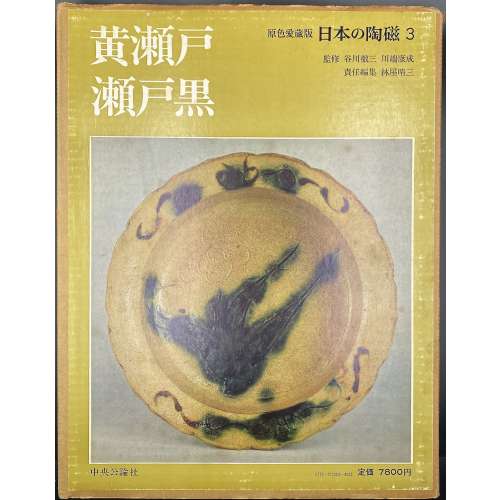 Hardcover volume, 35.3 x 27 cm, bound in grey cloth, blind stamped characters to front, brown characters to spine, in a glassine dust jacket, in a double slipcase, the outer case pictorial paper over cardboard, 36 x 28 cm, pp.: [4] [1] 2-88 (plates with photographs of 129 items), [2] 91-108 [3]. Seto ware [瀬戸焼] (Seto-yaki) – ceramics produced in and around the city of Seto in Aichi Prefecture. Yellow seto [黄瀬戸] (Kiseto) – a yellow glaze seto ware. Black seto [瀬戸黒] (Setoguro) – a black glaze seto ware. 日本の陶磁 – Japanese ceramics, series title. Contributors: Yasunari Kawabata [川端 康成] (Japanese, 1924 – 1972) – author. Tetsuzo Tanikawa [谷川 徹三] (Japanese, 1895 – 1989) – author. Seizo Hayashiya [林屋晴三] (Japanese, 1928 – 2017) – editor. Chūōkōron-sha [中央公論社] – publisher.
Hardcover volume, 35.3 x 27 cm, bound in grey cloth, blind stamped characters to front, brown characters to spine, in a glassine dust jacket, in a double slipcase, the outer case pictorial paper over cardboard, 36 x 28 cm, pp.: [4] [1] 2-88 (plates with photographs of 129 items), [2] 91-108 [3]. Seto ware [瀬戸焼] (Seto-yaki) – ceramics produced in and around the city of Seto in Aichi Prefecture. Yellow seto [黄瀬戸] (Kiseto) – a yellow glaze seto ware. Black seto [瀬戸黒] (Setoguro) – a black glaze seto ware. 日本の陶磁 – Japanese ceramics, series title. Contributors: Yasunari Kawabata [川端 康成] (Japanese, 1924 – 1972) – author. Tetsuzo Tanikawa [谷川 徹三] (Japanese, 1895 – 1989) – author. Seizo Hayashiya [林屋晴三] (Japanese, 1928 – 2017) – editor. Chūōkōron-sha [中央公論社] – publisher. -
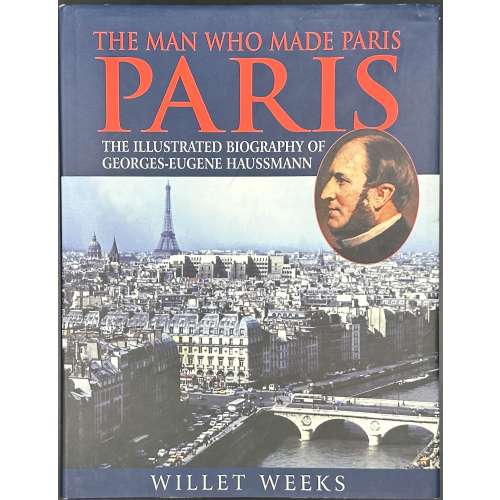 Hardcover volume, 25.3 x 19.6 cm, bound in blue cloth, gilt lettering to spine, pictorial dust jacket, crimson endpapers, pp.: [1-4] 5-160, ils. Title-page: THE MAN WHO MADE PARIS | PARIS | THE ILLUSTRATED BIOGRAPHY OF | GEORGES-EUGENE HAUSSMANN | WILLET WEEKS | Photographer of | scenes of Paris today | JEAN-CLAUDE MARTIN | (in frame) LONDON / HOUSE || Contributors: Willet Weeks (American)– author. Jean-Claude Martin (French-American) – photographer. Georges Eugène Haussmann (French, 1809 – 1891) – character.
Hardcover volume, 25.3 x 19.6 cm, bound in blue cloth, gilt lettering to spine, pictorial dust jacket, crimson endpapers, pp.: [1-4] 5-160, ils. Title-page: THE MAN WHO MADE PARIS | PARIS | THE ILLUSTRATED BIOGRAPHY OF | GEORGES-EUGENE HAUSSMANN | WILLET WEEKS | Photographer of | scenes of Paris today | JEAN-CLAUDE MARTIN | (in frame) LONDON / HOUSE || Contributors: Willet Weeks (American)– author. Jean-Claude Martin (French-American) – photographer. Georges Eugène Haussmann (French, 1809 – 1891) – character. -
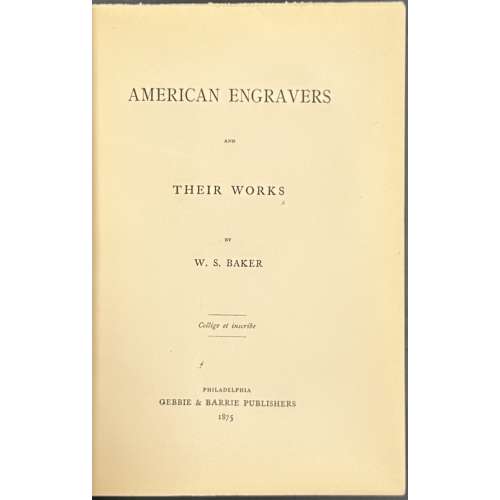 Hardcover, 19 x 13.8 cm, crimson buckram with tan paper label with lettering to spine; printed on laid paper; pp.: ffl [i-vi] vii-x] 11-184, collation 8vo, 1-118 124, total 92 leaves. Title-page: AMERICAN ENGRAVERS | AND | THEIR WORKS | BY | W. S. BAKER | Collige et inscribe | PHILADELPHIA | GEBBIE & BARRIE PUBLISHERS | 1875 || Motto: Collige et inscribe [Collect and record, lat.] Contributors: William Spohn Baker (American, 1824 – 1897) – author. George Gebbie (American, 1832 – 1892) – publisher. George Barrie (American, 1843 – 1918) – publisher. George R. Bonfield (British-American, 1802 – 1898) – dedicatee.
Hardcover, 19 x 13.8 cm, crimson buckram with tan paper label with lettering to spine; printed on laid paper; pp.: ffl [i-vi] vii-x] 11-184, collation 8vo, 1-118 124, total 92 leaves. Title-page: AMERICAN ENGRAVERS | AND | THEIR WORKS | BY | W. S. BAKER | Collige et inscribe | PHILADELPHIA | GEBBIE & BARRIE PUBLISHERS | 1875 || Motto: Collige et inscribe [Collect and record, lat.] Contributors: William Spohn Baker (American, 1824 – 1897) – author. George Gebbie (American, 1832 – 1892) – publisher. George Barrie (American, 1843 – 1918) – publisher. George R. Bonfield (British-American, 1802 – 1898) – dedicatee. -
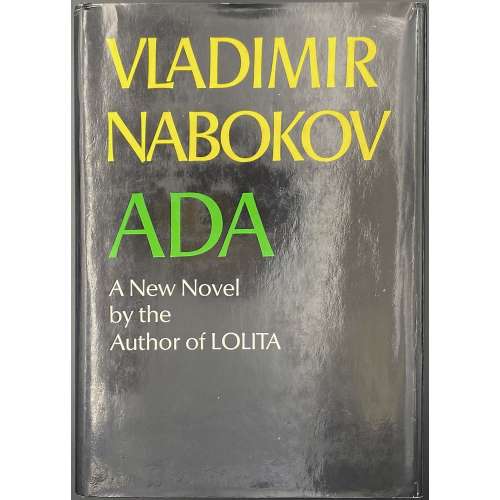 Hardcover volume, 21.8 x 15.5 x 6 cm, bound in black cloth with blind-stamped lettering to front and gilt lettering to spine, yellow endpapers, outer margin trimmed rough, pp.: [i-xiv] h.t./blank, advert./blank,t.p./copyright, dedicat./family, family/blank, edit./blank, [1-2] f.t./blank, 3-589 [5 blanks]; 608 pp (304 leaves) total; blue ink ms to fep “…from the Pembroke College Club of New York”; in a black dust jacket with yellow and green lettering to front and spine, portrait to back, unclipped $8.95. Title-page: VLADIMIR | NABOKOV | ADA | OR ARDOR: | A FAMILY | CHRONICLE | McGraw-Hill Book Company • New York • Toronto || Nabokov, Vladimir [Набоков, Владимир Владимирович] (Russian-American, 1899 – 1977)
Hardcover volume, 21.8 x 15.5 x 6 cm, bound in black cloth with blind-stamped lettering to front and gilt lettering to spine, yellow endpapers, outer margin trimmed rough, pp.: [i-xiv] h.t./blank, advert./blank,t.p./copyright, dedicat./family, family/blank, edit./blank, [1-2] f.t./blank, 3-589 [5 blanks]; 608 pp (304 leaves) total; blue ink ms to fep “…from the Pembroke College Club of New York”; in a black dust jacket with yellow and green lettering to front and spine, portrait to back, unclipped $8.95. Title-page: VLADIMIR | NABOKOV | ADA | OR ARDOR: | A FAMILY | CHRONICLE | McGraw-Hill Book Company • New York • Toronto || Nabokov, Vladimir [Набоков, Владимир Владимирович] (Russian-American, 1899 – 1977) -
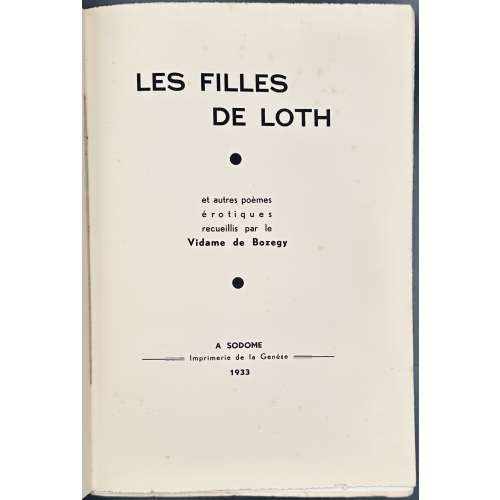 Softcover, french flapped wrappers, 29 x 19 cm, in glassine dustjacket, text printed on laid paper, pp.: [1-10] 11-256 [8], total 264 pages plus 11 plates out of 12, hand-coloured etchings on wove paper laid in, extraneous to collation. Wrappers detached from the block. Some pages uncut. Below is the missing plate, according to honesterotica.com:
Softcover, french flapped wrappers, 29 x 19 cm, in glassine dustjacket, text printed on laid paper, pp.: [1-10] 11-256 [8], total 264 pages plus 11 plates out of 12, hand-coloured etchings on wove paper laid in, extraneous to collation. Wrappers detached from the block. Some pages uncut. Below is the missing plate, according to honesterotica.com: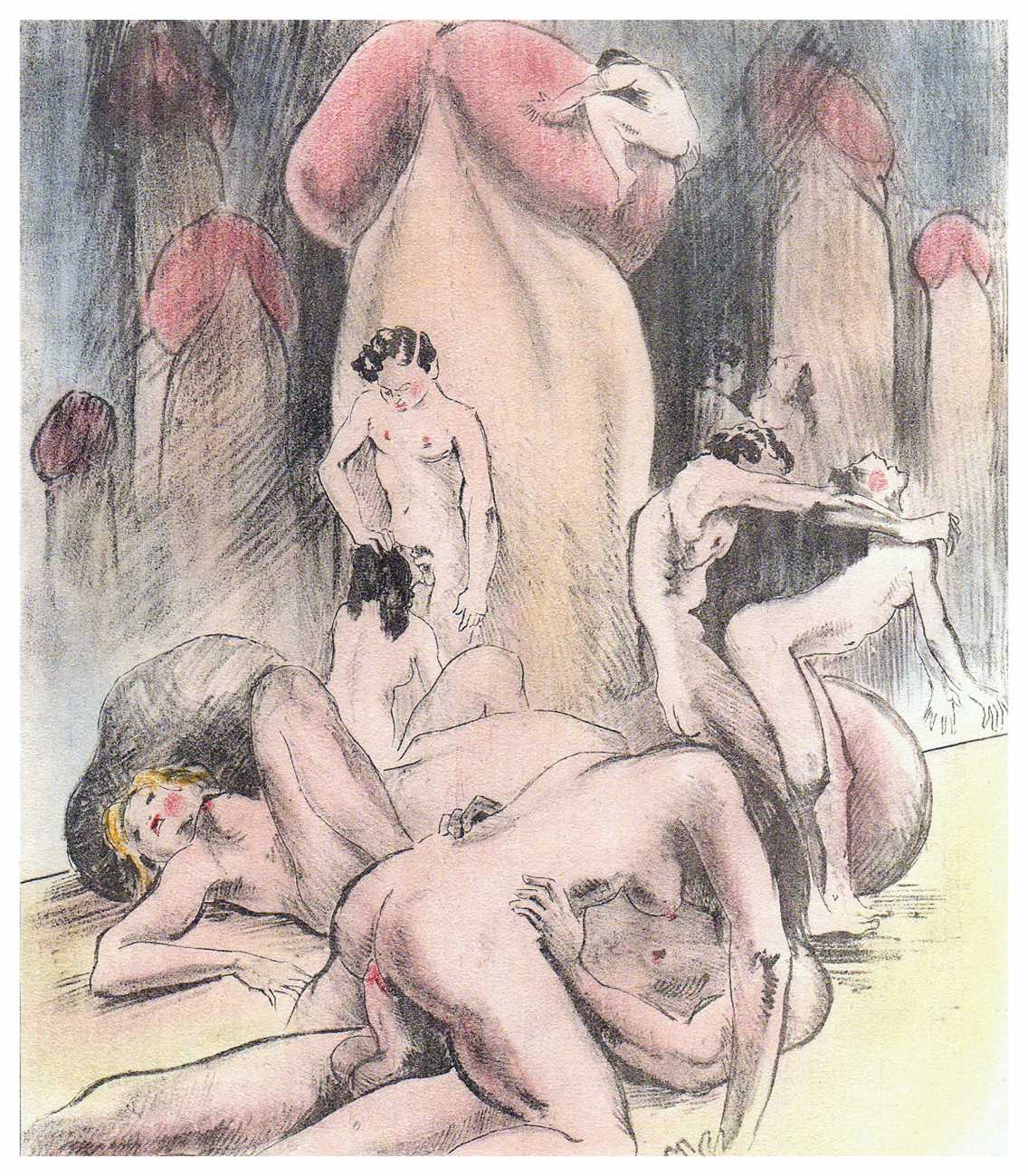 Title-page: LES FILLES | DE LOTH | • | et autres poèmes | érotiques | recueillis par le | Vidame de Bozegy | • | A SODOME | — Imprimerie de la Genèse — | 1933 ||
Edition limited to 500 copies, this is copy № 54.
Catalogue raisonné: Dutel III № 1575.
Edmond Dardenne Bernard [Vidame de Bozegy] (French, 20th c.) – author.
André Collot (French, 1897 – 1976) – artist.
Title-page: LES FILLES | DE LOTH | • | et autres poèmes | érotiques | recueillis par le | Vidame de Bozegy | • | A SODOME | — Imprimerie de la Genèse — | 1933 ||
Edition limited to 500 copies, this is copy № 54.
Catalogue raisonné: Dutel III № 1575.
Edmond Dardenne Bernard [Vidame de Bozegy] (French, 20th c.) – author.
André Collot (French, 1897 – 1976) – artist. -
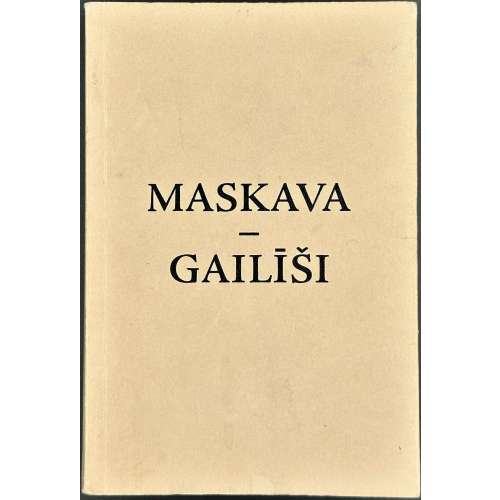 NEWSoftcover, light brown wrappers with French flaps, 163 x 110 mm, pp. [1-6] 7-357 [3]. Title-page: Venedikts Jerofejevs | MASKAVA | – | GAILĪŠI | No krievu valodas tulkojis | Uldis Tīrons | {Publisher’s device} | LIEPNIEKS & RITUPS || Translated from Russian by Uldis Tīrons Original title: Венедикт Ерофеев. Москва — Петушки Contributors: Ерофеев, Венедикт Васильевич [Yerofeyev, Venedikt] (Russian, 1938 – 1990) – author Uldis Tīrons (Latvian, b. 1956) – translator
NEWSoftcover, light brown wrappers with French flaps, 163 x 110 mm, pp. [1-6] 7-357 [3]. Title-page: Venedikts Jerofejevs | MASKAVA | – | GAILĪŠI | No krievu valodas tulkojis | Uldis Tīrons | {Publisher’s device} | LIEPNIEKS & RITUPS || Translated from Russian by Uldis Tīrons Original title: Венедикт Ерофеев. Москва — Петушки Contributors: Ерофеев, Венедикт Васильевич [Yerofeyev, Venedikt] (Russian, 1938 – 1990) – author Uldis Tīrons (Latvian, b. 1956) – translator -
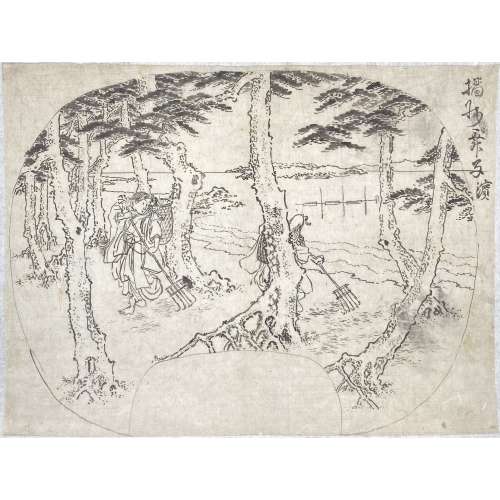 Artist: Veronica Miller attributes the drawing to Utagawa Sadahide [歌川 貞秀] (Japanese, 1807 – 1879), also known as Gountei Sadahide [五雲亭 貞秀]. A preparatory drawing for a fan print depicts two women raking pine needles along the scenic beach at Harima. Inscription at top right "Maiko Beach in Harima" (Harima Maiko no Hama) [播磨 舞子濱], which is now located in Hyōgo Prefecture. The view must be of the Akashi Strait, looking towards Awaji Island. Drawn on thin hanshita paper, mounted lightly at the top to a backing paper, but unbacked. Size: 240 x 319 mm. Attribution to Sadahide based on his design titled "Suma Bay: Matsukaze and Murasame" (see below):
Artist: Veronica Miller attributes the drawing to Utagawa Sadahide [歌川 貞秀] (Japanese, 1807 – 1879), also known as Gountei Sadahide [五雲亭 貞秀]. A preparatory drawing for a fan print depicts two women raking pine needles along the scenic beach at Harima. Inscription at top right "Maiko Beach in Harima" (Harima Maiko no Hama) [播磨 舞子濱], which is now located in Hyōgo Prefecture. The view must be of the Akashi Strait, looking towards Awaji Island. Drawn on thin hanshita paper, mounted lightly at the top to a backing paper, but unbacked. Size: 240 x 319 mm. Attribution to Sadahide based on his design titled "Suma Bay: Matsukaze and Murasame" (see below):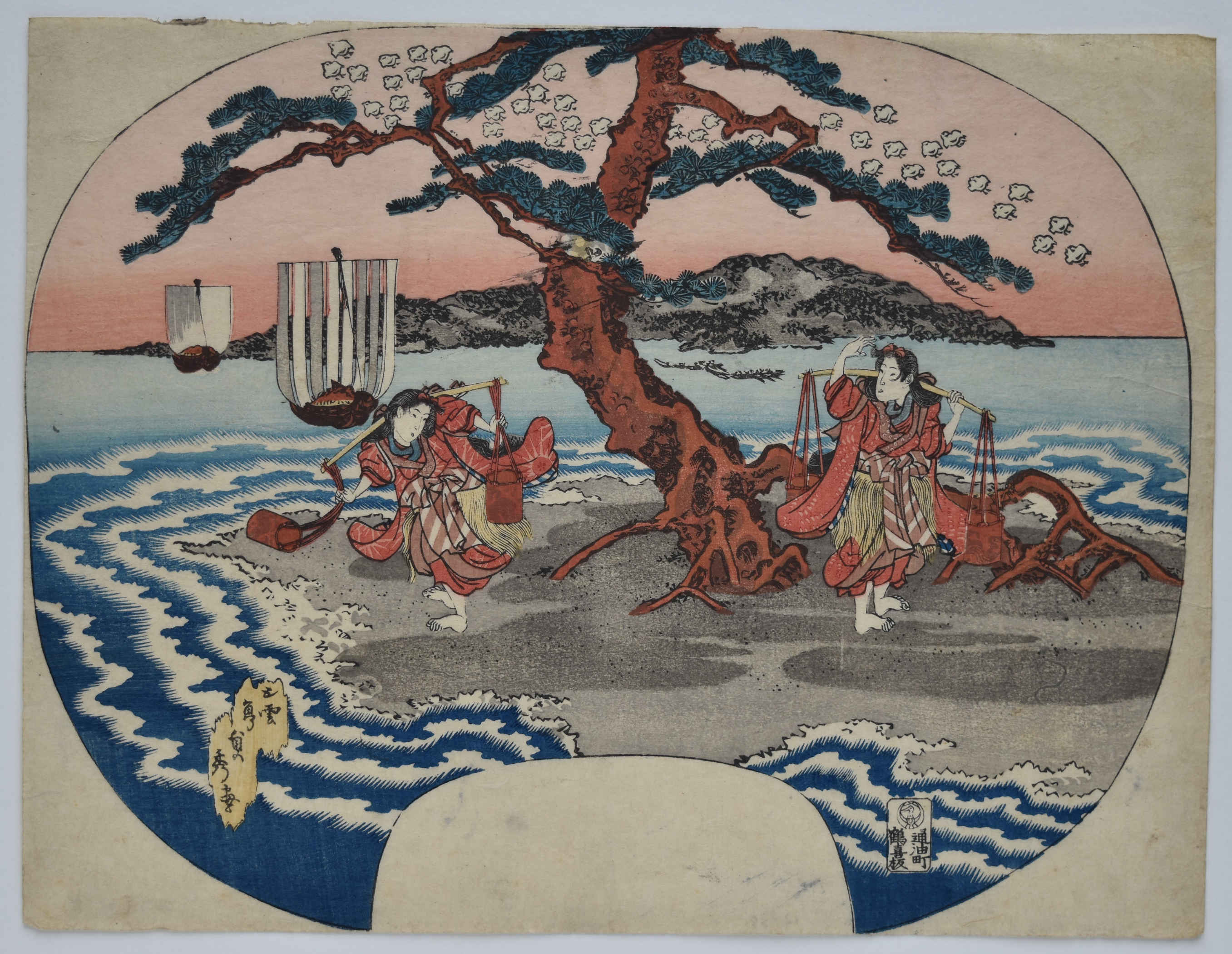 See also Maiko Beach, Harima Province, from the series Views of Famous Places in the Sixty-Odd Provinces,
See also Maiko Beach, Harima Province, from the series Views of Famous Places in the Sixty-Odd Provinces,
-
 Artist: Utagawa Kuniyoshi [歌川 國芳] (1798 – 1861). Kabuki actors Ichikawa Danjūrō VIII and Arashi Rikan III as sumo wrestlers Nuregami Chōgorō (L) and Hanaregoma Chōkichi (R), respectively. Signed: Ichiyûsai Kuniyoshi ga (一勇斎 國芳 画) in a double gourd-shaped cartouche with Yoshi Kiri seal. Publisher: No seal. Date seal and double nanushi censor seal: Mera & Watanabe, 1852. Media: Fan print (uchiwa-e, 団扇絵), 231 x 295 mm. Theme: Nine-act drama (11 scenes) Futatsu Chōchō Kuruwa Nikki [双蝶々曲輪日記] (A Diary of Two Butterflies in the Pleasure Quarters) written by Takeda Izumo II, Namiki Senryū I, Miyoshi Shōraku (7/1749) as puppet play Bunraku [文楽], adopted for Kabuki theatre by Arashi San'emon IV. “The sumo wrestler Nuregami Chōgorō is trying to ransom the courtesan Azuma for Yogoro, in whose debt he stands. Hiraoka Goemon, who is at odds with Yogorō and Azuma, is the patron of the amateur wrestler Hanaregoma Chōkichi. Chōgorō purposely loses to Chōkichi and then asks the latter to stop Goemon's ransoming of Azuma; Chōkichi refuses, however, and they quarrel. Admonished for his dissipation by his sister Oseki, Chōkichi is going to commit ritual suicide (seppuku) as an apology for his behavior, but Chōgorō, who happens along just then, prevents him. The two men swear blood brotherhood. […] The confrontation between Chōgorō and Chōkichi in the Sumōba scene, acted in the exaggerated style called aragoto, is a major highlight of the work. The scene in Yohei's home, known as Hikimado, presents the unfolding of Kabuki's eternal conflict between duty and feelings, here represented by the act of opening the skylight (hikimado) to which Chōgorō is tied”. [Samuel L. Leiter. Kabuki Encyclopedia: an English-language adaptation of Kabuki Jiten. — Westport, CT; London: Greenwood Press, 1979, pp. 70-71]. See also James R. Brandon and Samuel L. Leiter. Kabuki plays on stage, vol. 1, pp. 234-258. — Honolulu: University of Hawai'i Press, 2002. Actors: Ichikawa Danjūrō VIII [市川団十郎] (Japanese, 1823 – 1854); other names: Ichikawa Ebizō VI, Ichikawa Shinnosuke II. Arashi Rikan III [嵐璃寛] (Japanese, 1812 – 1863); other names Arashi Tokusaburō III, Arashi Kicchō I, Onoe Wasaburō I. Another print in this collection with the same theme: SVJP-0331.2020.
Artist: Utagawa Kuniyoshi [歌川 國芳] (1798 – 1861). Kabuki actors Ichikawa Danjūrō VIII and Arashi Rikan III as sumo wrestlers Nuregami Chōgorō (L) and Hanaregoma Chōkichi (R), respectively. Signed: Ichiyûsai Kuniyoshi ga (一勇斎 國芳 画) in a double gourd-shaped cartouche with Yoshi Kiri seal. Publisher: No seal. Date seal and double nanushi censor seal: Mera & Watanabe, 1852. Media: Fan print (uchiwa-e, 団扇絵), 231 x 295 mm. Theme: Nine-act drama (11 scenes) Futatsu Chōchō Kuruwa Nikki [双蝶々曲輪日記] (A Diary of Two Butterflies in the Pleasure Quarters) written by Takeda Izumo II, Namiki Senryū I, Miyoshi Shōraku (7/1749) as puppet play Bunraku [文楽], adopted for Kabuki theatre by Arashi San'emon IV. “The sumo wrestler Nuregami Chōgorō is trying to ransom the courtesan Azuma for Yogoro, in whose debt he stands. Hiraoka Goemon, who is at odds with Yogorō and Azuma, is the patron of the amateur wrestler Hanaregoma Chōkichi. Chōgorō purposely loses to Chōkichi and then asks the latter to stop Goemon's ransoming of Azuma; Chōkichi refuses, however, and they quarrel. Admonished for his dissipation by his sister Oseki, Chōkichi is going to commit ritual suicide (seppuku) as an apology for his behavior, but Chōgorō, who happens along just then, prevents him. The two men swear blood brotherhood. […] The confrontation between Chōgorō and Chōkichi in the Sumōba scene, acted in the exaggerated style called aragoto, is a major highlight of the work. The scene in Yohei's home, known as Hikimado, presents the unfolding of Kabuki's eternal conflict between duty and feelings, here represented by the act of opening the skylight (hikimado) to which Chōgorō is tied”. [Samuel L. Leiter. Kabuki Encyclopedia: an English-language adaptation of Kabuki Jiten. — Westport, CT; London: Greenwood Press, 1979, pp. 70-71]. See also James R. Brandon and Samuel L. Leiter. Kabuki plays on stage, vol. 1, pp. 234-258. — Honolulu: University of Hawai'i Press, 2002. Actors: Ichikawa Danjūrō VIII [市川団十郎] (Japanese, 1823 – 1854); other names: Ichikawa Ebizō VI, Ichikawa Shinnosuke II. Arashi Rikan III [嵐璃寛] (Japanese, 1812 – 1863); other names Arashi Tokusaburō III, Arashi Kicchō I, Onoe Wasaburō I. Another print in this collection with the same theme: SVJP-0331.2020. Reference images:
Reference images:
-
 Artist: Utagawa Kuniyoshi [歌川 國芳] (1798 – 1861). A beauty leaning on a fence and watching a dragonfly hovering above a flowering plant. Signed: Ichiyûsai Kuniyoshi ga (一勇斎 國芳 画) in a double gourd-shaped red cartouche. Publisher: Maruya Jinpachi, seal Jin [甚] (Marks 08-088 | 294d). No date/censor seal. Media: Fan print (uchiwa-e, 団扇絵), 234 x 301 mm.
Artist: Utagawa Kuniyoshi [歌川 國芳] (1798 – 1861). A beauty leaning on a fence and watching a dragonfly hovering above a flowering plant. Signed: Ichiyûsai Kuniyoshi ga (一勇斎 國芳 画) in a double gourd-shaped red cartouche. Publisher: Maruya Jinpachi, seal Jin [甚] (Marks 08-088 | 294d). No date/censor seal. Media: Fan print (uchiwa-e, 団扇絵), 234 x 301 mm. -
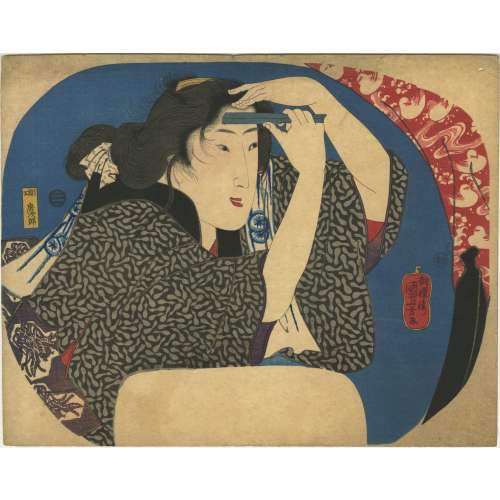 Artist: Utagawa Kuniyoshi [歌川 國芳] (Japanese, 1798 – 1861). Publisher: Ibaya Senzaburō [伊場屋仙三郎] (Japanese, fl. C. 1845 – 1847), seal: San [三] (Marks 11-001 | 127c). Carver: Matsushima Fusajirō [松嶋房次郎] (Japanese, fl. 1843 – 1850); seal [彫工房次郎] – Hori kō Fusajirō (Gordon Friese № 136) Signed: Chōōrō Kuniyoshi ga [朝櫻楼国芳画] in a red double gourd-shaped cartouche. Nanushi censor seal: Tanaka [田中]; V/1844 or II/1845. Media: Fan print (uchiwa-e, 団扇絵), 238 x 304 mm. Reference: Kuniyoshi Project. Series mentioned in Robert Schaap. Heroes and ghosts: Japanese prints by Kuniyoshi, 1797-1861.— Leiden: Hotei Publishing, 1998; p. 122 [LIB-1030.2016].
Artist: Utagawa Kuniyoshi [歌川 國芳] (Japanese, 1798 – 1861). Publisher: Ibaya Senzaburō [伊場屋仙三郎] (Japanese, fl. C. 1845 – 1847), seal: San [三] (Marks 11-001 | 127c). Carver: Matsushima Fusajirō [松嶋房次郎] (Japanese, fl. 1843 – 1850); seal [彫工房次郎] – Hori kō Fusajirō (Gordon Friese № 136) Signed: Chōōrō Kuniyoshi ga [朝櫻楼国芳画] in a red double gourd-shaped cartouche. Nanushi censor seal: Tanaka [田中]; V/1844 or II/1845. Media: Fan print (uchiwa-e, 団扇絵), 238 x 304 mm. Reference: Kuniyoshi Project. Series mentioned in Robert Schaap. Heroes and ghosts: Japanese prints by Kuniyoshi, 1797-1861.— Leiden: Hotei Publishing, 1998; p. 122 [LIB-1030.2016].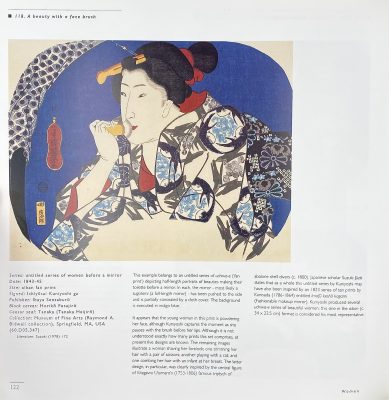
-
 Artist: Utagawa Kunisada [歌川 国貞], a.k.a. Utagawa Toyokuni III [三代 歌川 豊国] (Japanese, 1786 – 1865). Signed: Toyokuni ga [豊国 画] in a red toshidama cartouche Block carver: Yokokawa Takejirō [横川竹二郎] (Japanese, fl. 1845 – 1863), seal: 彫竹 – hori Take. Publisher: Ibaya Senzaburō [伊場屋仙三郎] (Japanese, fl. c. 1845 – 1847). Media: Untrimmed fan print (uchiwa-e), 238 x 304 mm. Title: Saiko (West River) [西江]; 西江 means the Xi River in China. Series: Chronicles of Elegant Women [風雅女史傳] (Fūga joshiden). Combined date seal and kiwame censor seal: Ansei 6 (1859). Other prints from the same series in this collection: SVJP-0216.2016 — Princess Sotoori:
Artist: Utagawa Kunisada [歌川 国貞], a.k.a. Utagawa Toyokuni III [三代 歌川 豊国] (Japanese, 1786 – 1865). Signed: Toyokuni ga [豊国 画] in a red toshidama cartouche Block carver: Yokokawa Takejirō [横川竹二郎] (Japanese, fl. 1845 – 1863), seal: 彫竹 – hori Take. Publisher: Ibaya Senzaburō [伊場屋仙三郎] (Japanese, fl. c. 1845 – 1847). Media: Untrimmed fan print (uchiwa-e), 238 x 304 mm. Title: Saiko (West River) [西江]; 西江 means the Xi River in China. Series: Chronicles of Elegant Women [風雅女史傳] (Fūga joshiden). Combined date seal and kiwame censor seal: Ansei 6 (1859). Other prints from the same series in this collection: SVJP-0216.2016 — Princess Sotoori:

-
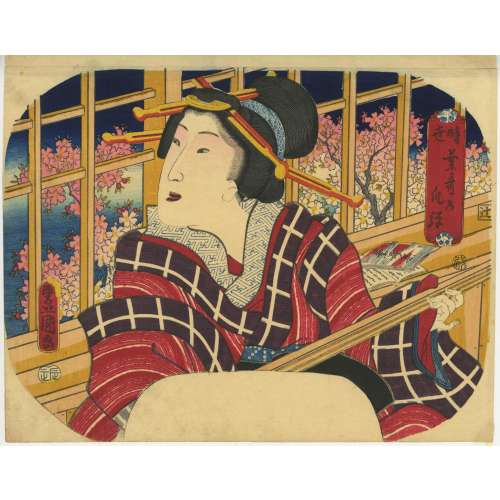 Artist: Utagawa Kunisada [歌川 国貞], a.k.a. Utagawa Toyokuni III [三代 歌川 豊国] (Japanese, 1786 – 1865). Signed: Toyokuni ga [豊国 画] in a red toshidama cartouche Publisher: Iseya Ichiemon [伊勢屋市右衛門] (Japanese, fl. c. 1820s – c. 1860s); seal Tsuji [辻] (Marks 16-029). Media: Untrimmed fan print (uchiwa-e), 225 x 295 mm, plus 10 mm paper strip glued on top (235 mm total height). Title: Plucking Popular Songs in Those Days [時世葉歌の爪弾] (Imayo ha-uta no tsuma-biki). Date seal and aratame seal: Ansei 3 (1856). Seller's Description: Uchiwa-e; picture intended for a summer fan. Here we see a relaxed beauty wearing loose layers of kimono and playing her shamisen instrument. She appears to be in the happy mood of spring, her singing inspired by the cherry blossoms in full bloom that we see outside of her window. She enjoys leisurely plucking with the plectrum of the shamisen and singing “ha-uta” (popular) songs. The title Ha-uta [葉歌] is normally written 端歌, which indicates a certain category of popular songs accompanied by shamisen with short texts that are drawn from daily life. Here however, the title葉歌 uses phonetically the same “ha葉“, referring to the title of the book of a collection of ha-uta songs, Matsu no ha [松の], which was published in five volumes in 1703 by Shûshôken 秀松軒. It is said that this collection of songs was written and sung by the blind (who were often musicians by livelihood). Behind her, lying on the window sill, we see two ha-uta songbooks, one open and one closed. The last half of the title tsuma-biki [爪弾] translates “to pluck with fingers” instead of a plectrum, which is the usual way of playing the shamisen.
Artist: Utagawa Kunisada [歌川 国貞], a.k.a. Utagawa Toyokuni III [三代 歌川 豊国] (Japanese, 1786 – 1865). Signed: Toyokuni ga [豊国 画] in a red toshidama cartouche Publisher: Iseya Ichiemon [伊勢屋市右衛門] (Japanese, fl. c. 1820s – c. 1860s); seal Tsuji [辻] (Marks 16-029). Media: Untrimmed fan print (uchiwa-e), 225 x 295 mm, plus 10 mm paper strip glued on top (235 mm total height). Title: Plucking Popular Songs in Those Days [時世葉歌の爪弾] (Imayo ha-uta no tsuma-biki). Date seal and aratame seal: Ansei 3 (1856). Seller's Description: Uchiwa-e; picture intended for a summer fan. Here we see a relaxed beauty wearing loose layers of kimono and playing her shamisen instrument. She appears to be in the happy mood of spring, her singing inspired by the cherry blossoms in full bloom that we see outside of her window. She enjoys leisurely plucking with the plectrum of the shamisen and singing “ha-uta” (popular) songs. The title Ha-uta [葉歌] is normally written 端歌, which indicates a certain category of popular songs accompanied by shamisen with short texts that are drawn from daily life. Here however, the title葉歌 uses phonetically the same “ha葉“, referring to the title of the book of a collection of ha-uta songs, Matsu no ha [松の], which was published in five volumes in 1703 by Shûshôken 秀松軒. It is said that this collection of songs was written and sung by the blind (who were often musicians by livelihood). Behind her, lying on the window sill, we see two ha-uta songbooks, one open and one closed. The last half of the title tsuma-biki [爪弾] translates “to pluck with fingers” instead of a plectrum, which is the usual way of playing the shamisen. -
 Artist: Utagawa Kunisada, a.k.a. Toyokuni III (Japanese, 1786 – 1865) [歌川 国貞]. Publisher: Ibaya Senzaburō [伊場屋仙三郎] (Japanese, fl. C. 1845 – 1847). Date aratame seal: Bunsei 12 (1829). Signed: Gototei Kunisada ga [五渡亭国貞画]. Media: Fan print (uchiwa-e), 238 x 267 mm (overtrimmed). Actor: Iwai Shijaku I [紫若] (Japanese, 1804 – 1845); other names: Iwai Matsunosuke I [岩井松之助]; Iwai Hanshirō VII, Iwai Shijaku I, Iwai Komurasaki I. The background is Arare-ko-mon [霰小紋] hail pattern. In the red cartouche at the top right is the series title "Edo no hana – itsutsu Karigane" (江戸の花 五雁金), to be translated as "Flowers of Edo - the five Karigane blood-brothers" (or "the five Karigane gang members"). Another print from the series in this collection: SVJP-0304.2019.
Artist: Utagawa Kunisada, a.k.a. Toyokuni III (Japanese, 1786 – 1865) [歌川 国貞]. Publisher: Ibaya Senzaburō [伊場屋仙三郎] (Japanese, fl. C. 1845 – 1847). Date aratame seal: Bunsei 12 (1829). Signed: Gototei Kunisada ga [五渡亭国貞画]. Media: Fan print (uchiwa-e), 238 x 267 mm (overtrimmed). Actor: Iwai Shijaku I [紫若] (Japanese, 1804 – 1845); other names: Iwai Matsunosuke I [岩井松之助]; Iwai Hanshirō VII, Iwai Shijaku I, Iwai Komurasaki I. The background is Arare-ko-mon [霰小紋] hail pattern. In the red cartouche at the top right is the series title "Edo no hana – itsutsu Karigane" (江戸の花 五雁金), to be translated as "Flowers of Edo - the five Karigane blood-brothers" (or "the five Karigane gang members"). Another print from the series in this collection: SVJP-0304.2019. -
 Kabuki actor Arashi Kichisaburō III [嵐吉三郎] as Sarushima Sōta [猿島惣太] in the play Hanamo Yoshida Iwao no Matsuwaka [花吉田岩尾松若] staged at Ichimura-za (市村座), theatre in Edo. Artist: Utagawa Kunisada, a.k.a. Toyokuni III (Japanese, 1786 – 1865) [歌川 国貞]. Publisher: Kojimaya Jūbei (Japanese, 1797-1869), seal: Hanmoto, Jū [板元, 十] (Marks 19-043 | 264c. Date seal and double nanushi censor seals Mera & Watanabe – 3rd month of Kaei 6 (1853). Signed: Toyokuni ga [豊国 画] in a red toshidama cartouche. Media: Fan print (uchiwa-e), 223 x 294 mm. Kabuki actor Arashi Kichisaburō III [嵐吉三郎] (Japanese, 1810 – 1864); other names: Arashi Daizaburō III, Arashi Kitsusaburō III Ref.: Art shop Ezoshi Ukiyoe new collection news, vol. 66, 2023.1 (Jan) # 30, p.8.
Kabuki actor Arashi Kichisaburō III [嵐吉三郎] as Sarushima Sōta [猿島惣太] in the play Hanamo Yoshida Iwao no Matsuwaka [花吉田岩尾松若] staged at Ichimura-za (市村座), theatre in Edo. Artist: Utagawa Kunisada, a.k.a. Toyokuni III (Japanese, 1786 – 1865) [歌川 国貞]. Publisher: Kojimaya Jūbei (Japanese, 1797-1869), seal: Hanmoto, Jū [板元, 十] (Marks 19-043 | 264c. Date seal and double nanushi censor seals Mera & Watanabe – 3rd month of Kaei 6 (1853). Signed: Toyokuni ga [豊国 画] in a red toshidama cartouche. Media: Fan print (uchiwa-e), 223 x 294 mm. Kabuki actor Arashi Kichisaburō III [嵐吉三郎] (Japanese, 1810 – 1864); other names: Arashi Daizaburō III, Arashi Kitsusaburō III Ref.: Art shop Ezoshi Ukiyoe new collection news, vol. 66, 2023.1 (Jan) # 30, p.8. -
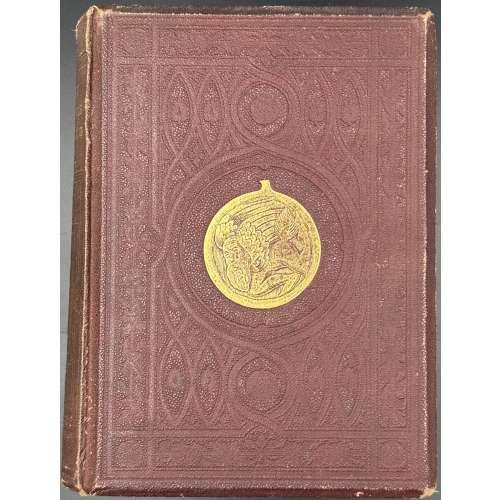 Hardcover, 23 x 17 x 4.7 cm, burgundy buckram, bevelled boards, blind geometrical design with a gilt medallion at the centre, gilt lettering and blind design elements to spine, text in frame, all edges red; pp.: [i-v] vi-xvi, [1] 2-494, [2 advert.], [1] 2-32 advert.], collation 4to: a-b4, B-3R4, a16. Title-page (red and black, in red frame): A HISTORY | OF | CARICATURE & GROTESQUE | {gothic letters} In Literature and Art. | By THOMAS WRIGHT, Esq., M.A., F.S.A., | Hon. M.R.S.L., &c.; | Corresponding Member of the Imperial Institute of France | (Académie des Inscriptions et Belles Lettres). |{double rules} | WITH | ILLUSTRATIONS FROM VARIOUS SOURCES, | DRAWN AND ENGRAVED BY | F. W. FAIRHOLT, Esq., F.S.A. | {double rules} | {gothic letters} London : | VIRTUE BROTHERS & CO., 1, AMEN CORNER, | PATERNOSTER ROW. | 1865. Contributors : Thomas Wright (British, 1792 – 1849) – author. Frederick William Fairholt (British, 1814 – 1866) – artist/engraver. Virtue Brothers & Co. (London) – publisher/printer.
Hardcover, 23 x 17 x 4.7 cm, burgundy buckram, bevelled boards, blind geometrical design with a gilt medallion at the centre, gilt lettering and blind design elements to spine, text in frame, all edges red; pp.: [i-v] vi-xvi, [1] 2-494, [2 advert.], [1] 2-32 advert.], collation 4to: a-b4, B-3R4, a16. Title-page (red and black, in red frame): A HISTORY | OF | CARICATURE & GROTESQUE | {gothic letters} In Literature and Art. | By THOMAS WRIGHT, Esq., M.A., F.S.A., | Hon. M.R.S.L., &c.; | Corresponding Member of the Imperial Institute of France | (Académie des Inscriptions et Belles Lettres). |{double rules} | WITH | ILLUSTRATIONS FROM VARIOUS SOURCES, | DRAWN AND ENGRAVED BY | F. W. FAIRHOLT, Esq., F.S.A. | {double rules} | {gothic letters} London : | VIRTUE BROTHERS & CO., 1, AMEN CORNER, | PATERNOSTER ROW. | 1865. Contributors : Thomas Wright (British, 1792 – 1849) – author. Frederick William Fairholt (British, 1814 – 1866) – artist/engraver. Virtue Brothers & Co. (London) – publisher/printer. -
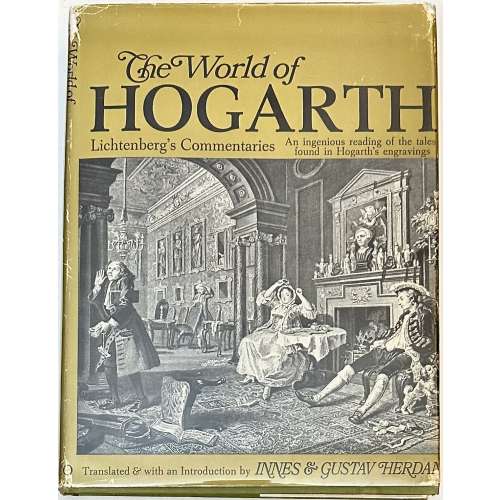 Hardcover volume, 25.3 x 19.3 cm, green cloth with gilt lettering to front and spine, pictorial dust jacket, pp.: [1 blank] [i-viii] ix-xxiii [xxiv blank] [2] 3-297 [298 blank] [8 blanks], 26 plates, unpaginated. MS inscription in black ink to ffl “David Tatham 1969”. Title-page: The World of | HOGARTH | Lichtenberg's Commentaries | on Hogarth's Engravings | TRANSLATED FROM THE GERMAN | AND WITH AN INTRODUCTION BY | INNES AND GUSTAV HERDAN | HOUGHTON MIFFLIN COMPANY BOSTON | The Riverside Press Cambridge | 1966 || Illustrations: A Harlot's Progress; Marriage-à-la-Mode; Strolling Actresses Dressing in a Barn; A Midnight Modern Conversation or The Bacchanalians; A Rake's Progress; The Four Times of the Day: Morning, Noon, Evening, Night. Edition: First printing w; Printed in the United States of America. Provenance (possibly): David Tatham (American, 1932 – 2023) Contributors: George Christoph Lichtenberg (German, 1743 – 1799) Innes Herdan (British, 1911 – ?) Gustav Herdan (German, 1897 – 1968) William Hogarth (British, 1697 – 1764)
Hardcover volume, 25.3 x 19.3 cm, green cloth with gilt lettering to front and spine, pictorial dust jacket, pp.: [1 blank] [i-viii] ix-xxiii [xxiv blank] [2] 3-297 [298 blank] [8 blanks], 26 plates, unpaginated. MS inscription in black ink to ffl “David Tatham 1969”. Title-page: The World of | HOGARTH | Lichtenberg's Commentaries | on Hogarth's Engravings | TRANSLATED FROM THE GERMAN | AND WITH AN INTRODUCTION BY | INNES AND GUSTAV HERDAN | HOUGHTON MIFFLIN COMPANY BOSTON | The Riverside Press Cambridge | 1966 || Illustrations: A Harlot's Progress; Marriage-à-la-Mode; Strolling Actresses Dressing in a Barn; A Midnight Modern Conversation or The Bacchanalians; A Rake's Progress; The Four Times of the Day: Morning, Noon, Evening, Night. Edition: First printing w; Printed in the United States of America. Provenance (possibly): David Tatham (American, 1932 – 2023) Contributors: George Christoph Lichtenberg (German, 1743 – 1799) Innes Herdan (British, 1911 – ?) Gustav Herdan (German, 1897 – 1968) William Hogarth (British, 1697 – 1764) -
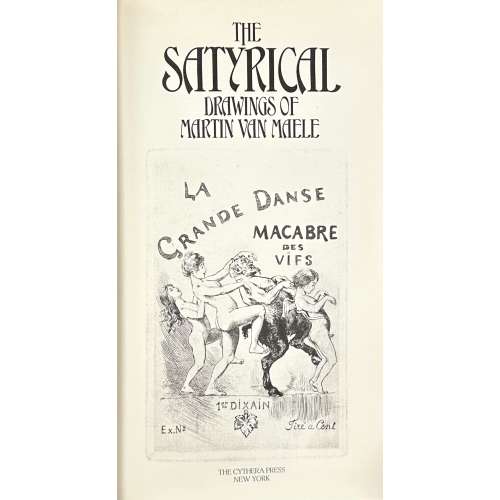 Hardcover volume 28.5 x 19 cm, bound in brown wrinkled buckram with framed gilt lettering and fleurons to front and framed gilt lettering to spine, in a pictorial dust jacket, green and yellow floral diaper endpapers, printed on laid paper, bottom and outer margins untrimmed. Collation: Eight unnumbered pages of text in English, incl. bibliography, plus 45 unnumbered leaves of plates (photomechanical) with captions in French. Facsimile reproduction of the published in ca. 1907-1908 ‘La grande danse macabre des vifs’, which can be loosely translated as ‘The great strange dance of life’ or ‘The great dance of death by the living’. Title-page: THE | SATYRICAL | DRAWINGS OF | MARTIN VAN MAELE | {vignette} | THE CYTHERA PRESS NEW YORK || SELECTED BIBLIOGRAPHY OF MAURICE FRANÇOIS ALFRED MARTIN VAN MAËLE [MARTIN VAN MAËLE] (FRENCH, 1863 – 1926) (ANONYMOUS). Sweet Seventeen. — Paris: Charles Carrington, 1910. ANSON, MARGUERITE. Une Société de flagellantes. — Paris: Charles Carrington. 1902. 31 illustrations by Van Maele and A. Lambrecht. Translation of The Merry Order of St. Bridget. APULEUS, LUCIUS. Les Métamorphoses, ou l’âne d'or. — Paris: Charles Carrington, 1905. Translation of The Golden Ass. The same Van Maele plates were probably used by the publisher for his English translation of the same work (Paris, 1904). ARETINO, PIETRO. Les Dialogues. 2 volumes. — Paris: Au Cabinet du Livre. 1927. Only the textual illustrations are by Van Maele. The other plates are by Viset. This is believed to be the Iast book that Van Maele illustrated. DESROIX, JACQUES. La Gynécocratte. — Paris: Charles Carrington, 1902. Translation of Gynecocracy. FRANCE, ANATOLE. Thaïs. — Paris: Charles Carrington, 1901. English translation. JUSANGE. PIERRE DE. La Comtesse au foulet. — Paris: Collection des Orties Blanches, s.d. SACHER-MASOCH. La Vénus a la fourrure. — Paris: Charles Carrington, 1902. VAN MAELE, MARTIN. La Grande Danse macabre des vifs. — Paris: Charles Carrington, ca. 1907-8. VERLAINE, PAUL. La Trilogie érotique. — Paris: Charles Carrington, 1907. Reprinted, Brussels, 1931. The original edition is rare. VILLIOT, JEAN DE. Camille et moi. — Paris: Charles Carrington, 1904. Translation of Frank and I. VILLIOT, JEAN DE. Dix-sept ans. — Paris: Librairie des Bibliophiles Parisiens, Charles Carrington, 1905. Translation of Sweet Seventeen. VILLIOT, JEAN DE. La Flagellation amoureuse. — Paris: Charles Carrington. 1904. VILLIOT, JEAN DE. La Flagellation des femmes en Allemagne. — Paris: Charles Carrington. 1901. Translation of Nell in Bridewell. VILLIOT, JEAN DE. Volées de bois vert. — Paris: Librairie des Bibliophiles Parisiens, Charles Carrington, 1905. (ANONYMOUS): Flèches de plomb. BAUDELAIRE, CHARLES. Les Fleurs du mal. BERANGER. Chansons érotiques. CHODER LOS DE LACLOS. Les Liaisons dangereuses. — Paris: 1908. GAUTIER, THEOPHILE. Lettre au Président. HARAUCOURT. Légende des sexes. — Paris, 1908. MICHELET, JULES. La Sorcière. — Paris, 1911.
Hardcover volume 28.5 x 19 cm, bound in brown wrinkled buckram with framed gilt lettering and fleurons to front and framed gilt lettering to spine, in a pictorial dust jacket, green and yellow floral diaper endpapers, printed on laid paper, bottom and outer margins untrimmed. Collation: Eight unnumbered pages of text in English, incl. bibliography, plus 45 unnumbered leaves of plates (photomechanical) with captions in French. Facsimile reproduction of the published in ca. 1907-1908 ‘La grande danse macabre des vifs’, which can be loosely translated as ‘The great strange dance of life’ or ‘The great dance of death by the living’. Title-page: THE | SATYRICAL | DRAWINGS OF | MARTIN VAN MAELE | {vignette} | THE CYTHERA PRESS NEW YORK || SELECTED BIBLIOGRAPHY OF MAURICE FRANÇOIS ALFRED MARTIN VAN MAËLE [MARTIN VAN MAËLE] (FRENCH, 1863 – 1926) (ANONYMOUS). Sweet Seventeen. — Paris: Charles Carrington, 1910. ANSON, MARGUERITE. Une Société de flagellantes. — Paris: Charles Carrington. 1902. 31 illustrations by Van Maele and A. Lambrecht. Translation of The Merry Order of St. Bridget. APULEUS, LUCIUS. Les Métamorphoses, ou l’âne d'or. — Paris: Charles Carrington, 1905. Translation of The Golden Ass. The same Van Maele plates were probably used by the publisher for his English translation of the same work (Paris, 1904). ARETINO, PIETRO. Les Dialogues. 2 volumes. — Paris: Au Cabinet du Livre. 1927. Only the textual illustrations are by Van Maele. The other plates are by Viset. This is believed to be the Iast book that Van Maele illustrated. DESROIX, JACQUES. La Gynécocratte. — Paris: Charles Carrington, 1902. Translation of Gynecocracy. FRANCE, ANATOLE. Thaïs. — Paris: Charles Carrington, 1901. English translation. JUSANGE. PIERRE DE. La Comtesse au foulet. — Paris: Collection des Orties Blanches, s.d. SACHER-MASOCH. La Vénus a la fourrure. — Paris: Charles Carrington, 1902. VAN MAELE, MARTIN. La Grande Danse macabre des vifs. — Paris: Charles Carrington, ca. 1907-8. VERLAINE, PAUL. La Trilogie érotique. — Paris: Charles Carrington, 1907. Reprinted, Brussels, 1931. The original edition is rare. VILLIOT, JEAN DE. Camille et moi. — Paris: Charles Carrington, 1904. Translation of Frank and I. VILLIOT, JEAN DE. Dix-sept ans. — Paris: Librairie des Bibliophiles Parisiens, Charles Carrington, 1905. Translation of Sweet Seventeen. VILLIOT, JEAN DE. La Flagellation amoureuse. — Paris: Charles Carrington. 1904. VILLIOT, JEAN DE. La Flagellation des femmes en Allemagne. — Paris: Charles Carrington. 1901. Translation of Nell in Bridewell. VILLIOT, JEAN DE. Volées de bois vert. — Paris: Librairie des Bibliophiles Parisiens, Charles Carrington, 1905. (ANONYMOUS): Flèches de plomb. BAUDELAIRE, CHARLES. Les Fleurs du mal. BERANGER. Chansons érotiques. CHODER LOS DE LACLOS. Les Liaisons dangereuses. — Paris: 1908. GAUTIER, THEOPHILE. Lettre au Président. HARAUCOURT. Légende des sexes. — Paris, 1908. MICHELET, JULES. La Sorcière. — Paris, 1911. -
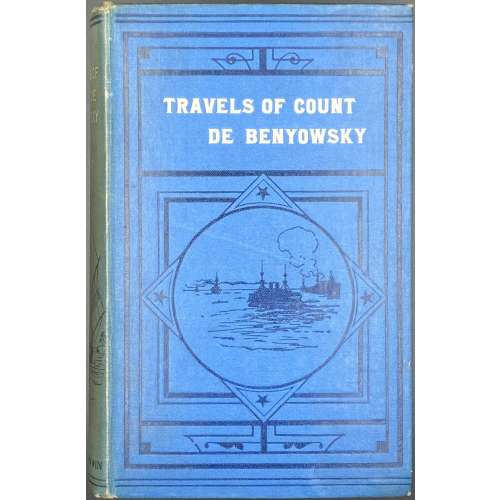 Hardcover volume in 8vo, 20.4 x 13.7 cm, blue cloth with black pictorial stamping and white embossed lettering to front cover and spine, spine sunned, head and tail frayed. Title-page: ❦❦❦ THE MEMOIRS AND | TRAVELS OF MAURITIUS | AUGUSTUS COUNT DE | BENYOWSKY ❦❦❦ | IN SIBERIA, KAMCHATKA, JAPAN, | THE LIUKIU ISLANDS AND FORMOSA | FROM THE TRANSLATION OF HIS | ORIGINAL MANUSCRIPT (1741–1771), | BY WILLIAM NICHOLSON, F.R.S., 1790 | EDITED BY CAPTAIN | PASFIELD OLIVER | ILLUSTRATED | LONDON: T. FISHER UNWIN, | PATERNOSTER SQUARE. MDCCCXCVIII || Collation/Pagination: [1]7 2-258; blue advertisement sheet laid in. [1, 2] – serial h.t. "The Adventure Series" / advert. THE ADVENTURE SERIES. Illustrated. Popular Re-issue, large cr. 8vo, 3s. 6d. 8 titles, [3, 4] – t.p. / blank, [5] 6-9 contents, [10] blank, [11, 12] missing, [13] 14-52 introduction, 53-399, [400] colophon: THE GRESHAM PRESS, | URWIN BROTHERS, | WORKING IN LONDON. Total number of leaves 199; 398 pages; one leaf of the first gathering missing (pp. 11/12 list of illustrations. No illustrations in this volume. Compared to another copy of the same edition, LIB-2701.2021, besides the binding: no list of illustrations, no illustrations, different colophon, different advertisement, slightly different h.t. Contributors: Publisher: T. Fisher Unwin (London); Thomas Fisher Unwin (British, 1848 – 1935). Author: Maurice Auguste count de Benyowsky [Мориц Август Бенёвский] (Polish-Slovak-Hungarian, 1746 –1786). Editor: Samuel Pasfield Oliver (British, 1838 – 1907). Translator: William Nicholson (British, 1753 – 1815). Originally published in 1790, in London (I have not seen it anywhere) and in Dublin by P. Wogan [etc.], and in 1791 in French, in Paris by Buisson; see LIB-2742.2021. For the 1904 edition, see LIB-2703.2021.
Hardcover volume in 8vo, 20.4 x 13.7 cm, blue cloth with black pictorial stamping and white embossed lettering to front cover and spine, spine sunned, head and tail frayed. Title-page: ❦❦❦ THE MEMOIRS AND | TRAVELS OF MAURITIUS | AUGUSTUS COUNT DE | BENYOWSKY ❦❦❦ | IN SIBERIA, KAMCHATKA, JAPAN, | THE LIUKIU ISLANDS AND FORMOSA | FROM THE TRANSLATION OF HIS | ORIGINAL MANUSCRIPT (1741–1771), | BY WILLIAM NICHOLSON, F.R.S., 1790 | EDITED BY CAPTAIN | PASFIELD OLIVER | ILLUSTRATED | LONDON: T. FISHER UNWIN, | PATERNOSTER SQUARE. MDCCCXCVIII || Collation/Pagination: [1]7 2-258; blue advertisement sheet laid in. [1, 2] – serial h.t. "The Adventure Series" / advert. THE ADVENTURE SERIES. Illustrated. Popular Re-issue, large cr. 8vo, 3s. 6d. 8 titles, [3, 4] – t.p. / blank, [5] 6-9 contents, [10] blank, [11, 12] missing, [13] 14-52 introduction, 53-399, [400] colophon: THE GRESHAM PRESS, | URWIN BROTHERS, | WORKING IN LONDON. Total number of leaves 199; 398 pages; one leaf of the first gathering missing (pp. 11/12 list of illustrations. No illustrations in this volume. Compared to another copy of the same edition, LIB-2701.2021, besides the binding: no list of illustrations, no illustrations, different colophon, different advertisement, slightly different h.t. Contributors: Publisher: T. Fisher Unwin (London); Thomas Fisher Unwin (British, 1848 – 1935). Author: Maurice Auguste count de Benyowsky [Мориц Август Бенёвский] (Polish-Slovak-Hungarian, 1746 –1786). Editor: Samuel Pasfield Oliver (British, 1838 – 1907). Translator: William Nicholson (British, 1753 – 1815). Originally published in 1790, in London (I have not seen it anywhere) and in Dublin by P. Wogan [etc.], and in 1791 in French, in Paris by Buisson; see LIB-2742.2021. For the 1904 edition, see LIB-2703.2021.



